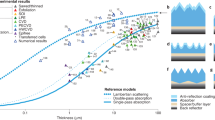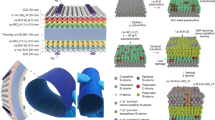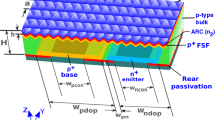Abstract
The high natural abundance of silicon, together with its excellent reliability and good efficiency in solar cells, suggest its continued use in production of solar energy, on massive scales, for the foreseeable future. Although organics, nanocrystals, nanowires and other new materials hold significant promise, many opportunities continue to exist for research into unconventional means of exploiting silicon in advanced photovoltaic systems. Here, we describe modules that use large-scale arrays of silicon solar microcells created from bulk wafers and integrated in diverse spatial layouts on foreign substrates by transfer printing. The resulting devices can offer useful features, including high degrees of mechanical flexibility, user-definable transparency and ultrathin-form-factor microconcentrator designs. Detailed studies of the processes for creating and manipulating such microcells, together with theoretical and experimental investigations of the electrical, mechanical and optical characteristics of several types of module that incorporate them, illuminate the key aspects.
This is a preview of subscription content, access via your institution
Access options
Subscribe to this journal
Receive 12 print issues and online access
$259.00 per year
only $21.58 per issue
Buy this article
- Purchase on Springer Link
- Instant access to full article PDF
Prices may be subject to local taxes which are calculated during checkout





Similar content being viewed by others
References
Campbell, P. & Green, M. A. Light trapping properties of pyramidally textured surfaces. J. Appl. Phys. 62, 243–249 (1987).
Heine, C. & Morf, R. H. Submicrometer gratings for solar-energy applications. Appl. Opt. 34, 2476–2482 (1995).
Feng, N.-N. et al. Design of highly efficient light-trapping structures for thin-film crystalline silicon solar cells. IEEE Trans. Electron Devices 54, 1926–1933 (2007).
Wenham, S. R., Honsberg, C. B. & Green, M. A. Buried contact silicon solar cells. Sol. Energy Mater. Sol. Cells 34, 101–110 (1994).
Sinton, R. A., Kwark, Y., Gan, J. Y. & Swanson, R. M. 27.5-Percent silicon concentrator solar-cells. IEEE Electron Devices Lett. 7, 567–569 (1986).
Kerschaver, E. V. & Beaucarne, G. Back-contact solar cells: A Review. Prog. Photovolt. 14, 107–123 (2006).
Zhao, J. H., Wang, A. H. & Green, M. A. 24.5% efficiency silicon PERT cells on MCZ substrates and 24.7% efficiency PERL cells on FZ substrates. Prog. Photovolt. 7, 471–474 (1999).
Biancardo, M. et al. Characterization of microspherical semi-transparent solar cells and modules. Sol. Energy 81, 711–716 (2007).
Liu, Z. X. et al. A concentrator module of spherical Si solar cell. Sol. Energy Mater. Sol. Cells 91, 1805–1810 (2007).
Minemoto, T. & Takakura, H. Fabrication of spherical silicon crystals by dropping method and their application to solar cells. Jpn. J. Appl. Phys. 46, 4016–4020 (2007).
Taguchi, M. et al. HIT (TM) cells—high-efficiency crystalline Si cells with novel structure. Prog. Photovolt. 8, 503–513 (2000).
Weber, K. J. et al. A novel low-cost, high-efficiency micromachined silicon solar cell. IEEE Electron Devices Lett. 25, 37–39 (2004).
Verlinden, P. J. et al. Sliver (R) solar cells: A new thin-crystalline silicon photovoltaic technology. Sol. Energy Mater. Sol. Cells 90, 3422–3430 (2006).
Brendel, R., Bergmann, R. B., Lolgen, P., Wolf, M. & Werner, J. H. Ultrathin crystalline silicon solar cells on glass substrates. Appl. Phys. Lett. 70, 390–392 (1997).
Brendel, R. Review of layer transfer processes for crystalline thin-film silicon solar cells. Jpn. J. Appl. Phys. 40, 4431–4439 (2001).
Tayanaka, H., Yamauchi, K. & Matsushita, T. Thin-film crystalline silicon solar cells obtained by separation of a porous silicon sacrificial layer. Proc. 2nd World Conf. Photovolt. Sol. Energy Conv. 1272–1275 (Institute of Electrical and Electronics Engineers (IEEE), 1998).
Yamamoto, K. et al. Thin-film poly-Si solar cells on glass substrate fabricated at low temperature. Appl. Phys. A 69, 179–185 (1999).
Shah, A. et al. Photovoltaic Specialists Conference, Conference Record of the Twenty-Sixth IEEE 569–574 (Institute of Electrical and Electronics Engineers (IEEE), 1997).
Bergmann, R. B. Crystalline Si thin-film solar cells: A review. Appl. Phys. A 69, 187–194 (1999).
Green, M. A. Crystalline and thin-film silicon solar cells: State of the art and future potential. Sol. Energy 74, 181–192 (2003).
Kazmerski, L. L. Solar photovoltaics R&D at the tipping point: A 2005 technology overview. J. Electron Spectrosc. Relat. Phenom. 150, 105–135 (2006).
Mack, S., Meitl, M. A., Baca, A. J., Zhu, Z. T. & Rogers, J. A. Mechanically flexible thin-film transistors that use ultrathin ribbons of silicon derived from bulk wafers. Appl. Phys. Lett. 88, 213101 (2006).
Ko, H. C., Baca, A. J. & Rogers, J. A. Bulk quantities of single-crystal silicon micro-/nanoribbons generated from bulk wafers. Nano Lett. 6, 2318–2324 (2006).
Baca, A. J. et al. Printable single-crystal silicon micro/nanoscale ribbons, platelets and bars generated from bulk wafers. Adv. Funct. Mater. 17, 3051–3062 (2007).
Meitl, M. A. et al. Stress focusing for controlled fracture in microelectromechanical systems. Appl. Phys. Lett. 90, 083110 (2007).
Meitl, M. A. et al. Transfer printing by kinetic control of adhesion to an elastomeric stamp. Nature Mater. 5, 33–38 (2006).
Lee, K. J. et al. Large-area, selective transfer of microstructured silicon: A printing-based approach to high-performance thin-film transistors supported on flexible substrates. Adv. Mater. 17, 2332–2336 (2005).
Wilson, R. G., Stevie, F. A. & Magee, C. W. Secondary Ion Mass Spectrometry: A Practical Handbook for Depth Profiling and Bulk Impurity Analysis (Wiley, 1989).
Hull, R. (ed.) Properties of Crystalline Silicon (The Institution of Electrical Engineers (IEE), 1999).
Budianu, E., Purica, M., Rusu, E., Manea, E. & Gavrila, R. Semiconductor Conf. 2002. CAS 2002 Proc. Int. Vol. 1 (Institute of Electrical and Electronics Engineers (IEEE), 2002).
Clugston, D. A. & Basore, P. A. Photovoltaic Specialists Conf. 1997., Conf. Record of the Twenty-Sixth IEEE 207–210 (Institute of Electrical and Electronics Engineers (IEEE), 1997).
Kunnavakkam, M. V. et al. Low-cost, low-loss microlens arrays fabricated by soft-lithography replication process. Appl. Phys. Lett. 82, 1152–1154 (2003).
Acknowledgements
We thank T. Banks, K. Colravy and D. Sievers for help with processing, T. Spila for assistance with secondary-ion mass spectrometry measurements and H. Kim and D. Stevenson for help with photography. The materials parts of this effort were supported by the US Department of Energy (DoE), Division of Materials Sciences, under award DE-FG02-07ER46471, through the Materials Research Laboratory (MRL). The general characterization facilities were provided through the MRL with support from the University of Illinois and from DoE grants DE-FG02-07ER46453 and DE-FG02-07ER46471. The mechanics theory and the transfer-printing systems were developed under support from the Center for Nanoscale Chemical Electrical Mechanical Manufacturing Systems at the University of Illinois (funded by the NSF under grant DMI-0328162). J.Y. and J.B.G. acknowledge support from a Beckman postdoctoral fellowship. A.J.B. acknowledges support from the Department of Defense Science, Mathematics and Research for Transformation (SMART) fellowship.
Author information
Authors and Affiliations
Contributions
J.Y., J.A.L., R.G.N., P.M.F., Y.H., A.R. and J.A.R. designed the experiments. J.Y., A.J.B., S.-I.P., P.E., L.L., R.H.K., T.-H.K., M.J.M., B.Y.A., E.B.D., J.A.L., R.G.N., P.M.F., Y.H., A.R. and J.A.R. carried out experiments. J.Y., A.J.B., S.-I.P., J.A.L., R.G.N., P.M.F., Y.H., A.R. and J.A.R. analysed the data. P.E., J.Y., R.H.K., T.-H.K., J.A.L., R.G.N., P.M.F., Y.H., A.R. and J.A.R. contributed to transfer printing. J.X., S.W., Y.H., J.A.L., R.G.N., P.M.F., Y.H., A.R. and J.A.R. contributed to mechanics modelling and analysis. J.B.G., J.A.L., R.G.N., P.M.F., Y.H., A.R. and J.A.R. contributed to optics simulation. J.Y., A.J.B., J.A.L., R.G.N., P.M.F., Y.H., A.R. and J.A.R. wrote the paper.
Corresponding author
Supplementary information
Supplementary Information
Supplementary Information (PDF 1256 kb)
Supplementary Information
Supplementary Movie (MOV 18591 kb)
Rights and permissions
About this article
Cite this article
Yoon, J., Baca, A., Park, SI. et al. Ultrathin silicon solar microcells for semitransparent, mechanically flexible and microconcentrator module designs. Nature Mater 7, 907–915 (2008). https://doi.org/10.1038/nmat2287
Received:
Accepted:
Published:
Issue Date:
DOI: https://doi.org/10.1038/nmat2287
This article is cited by
-
Flexible solar cells based on foldable silicon wafers with blunted edges
Nature (2023)
-
Interface effect of graphene oxide in MoS2 layered nanosheets for thermoelectric application
Journal of Materials Science: Materials in Electronics (2022)
-
Material and structural design of microsupercapacitors
Journal of Solid State Electrochemistry (2022)
-
Stick-and-play system based on interfacial adhesion control enhanced by micro/nanostructures
Nano Research (2021)
-
High-performance printed electronics based on inorganic semiconducting nano to chip scale structures
Nano Convergence (2020)



